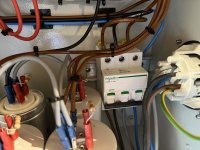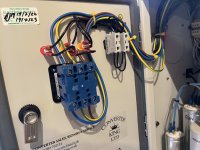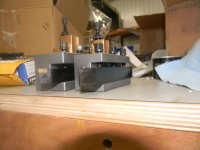A short pictorial of the Variator bearing and assembly detail, if I get the time I will shoot a video of the process to re-fit the Variator and belts so its more obvious as to how things have been designed - naturally this all hinges on the final item being successful in its re-design and all the parts fit and go together!
The first task is to slide the new shaft into the Variator yoke from the door end on the motor cabinet so its easy to do rather than have to come in from the back end deep inside the bowls of the machine where access is all but impossible, major design criteria #1.

As there are no bearings fitted at this stage into the yoke arm so the shaft is free to insert, the Variator assembly complete with belts looped over the pulleys is then held between the yoke arms and the shaft passed through the seals of the Variator and out the other end. The small insert which forms part of the slip ring is already bolted on, this holds the end pulley flange to the assembly during assembly.

The end of the shaft can now be tapped through and into the bearing races pressed into the yoke arm opposite the opening, the shaft will seat on the bearings as it has a step machined into it.

To hold this from moving outwards there is a washer and bolt fixed into the shaft hold it in place

Once this is done the shaft is 'fixed' at one end and now you can slide in the two bearings into the yoke at the insert end, these are push fit. They are secured by a pressure ring holding the bearings in place and then a washer and bolt are added to finalise the shaft installation.



The Variator slides fore and aft on the shaft and during the re-design we (hopefully) worked out that there should be enough space to position the split ring over the shaft and align with the insert which is already fixed in place and fit the three bolts, this process might be the only fiddly part but I'm hoping as the insert is already fixed the hole alignment should be good and therefor the bolts should go in fairly easily, once in they are nipped up with an Allen key and some thread lock added beforehand.
These images show the movement available for the Variator self alignment and the completed fitment of the split ring.


The first task is to slide the new shaft into the Variator yoke from the door end on the motor cabinet so its easy to do rather than have to come in from the back end deep inside the bowls of the machine where access is all but impossible, major design criteria #1.

As there are no bearings fitted at this stage into the yoke arm so the shaft is free to insert, the Variator assembly complete with belts looped over the pulleys is then held between the yoke arms and the shaft passed through the seals of the Variator and out the other end. The small insert which forms part of the slip ring is already bolted on, this holds the end pulley flange to the assembly during assembly.

The end of the shaft can now be tapped through and into the bearing races pressed into the yoke arm opposite the opening, the shaft will seat on the bearings as it has a step machined into it.

To hold this from moving outwards there is a washer and bolt fixed into the shaft hold it in place

Once this is done the shaft is 'fixed' at one end and now you can slide in the two bearings into the yoke at the insert end, these are push fit. They are secured by a pressure ring holding the bearings in place and then a washer and bolt are added to finalise the shaft installation.



The Variator slides fore and aft on the shaft and during the re-design we (hopefully) worked out that there should be enough space to position the split ring over the shaft and align with the insert which is already fixed in place and fit the three bolts, this process might be the only fiddly part but I'm hoping as the insert is already fixed the hole alignment should be good and therefor the bolts should go in fairly easily, once in they are nipped up with an Allen key and some thread lock added beforehand.
These images show the movement available for the Variator self alignment and the completed fitment of the split ring.


Last edited:


















